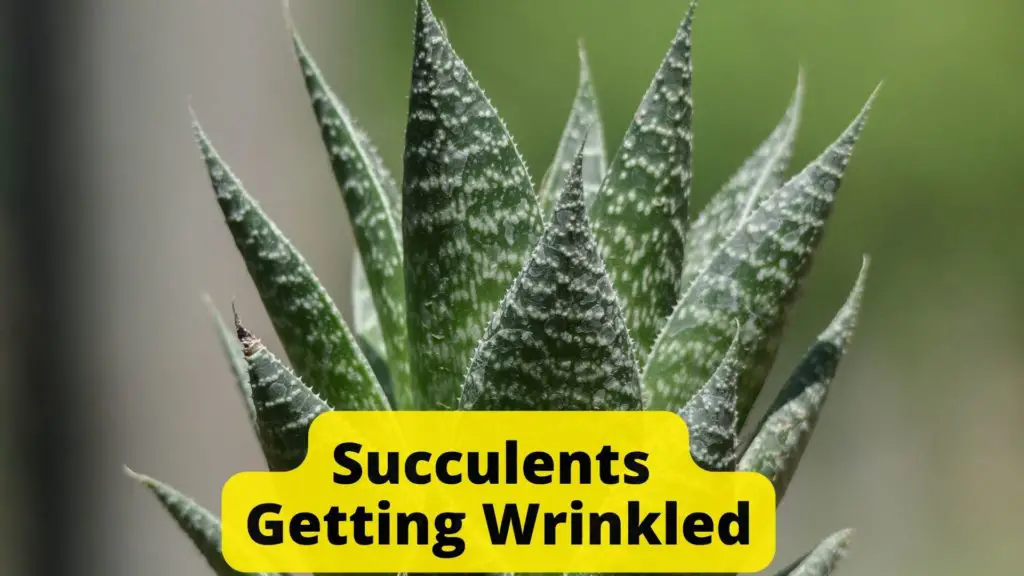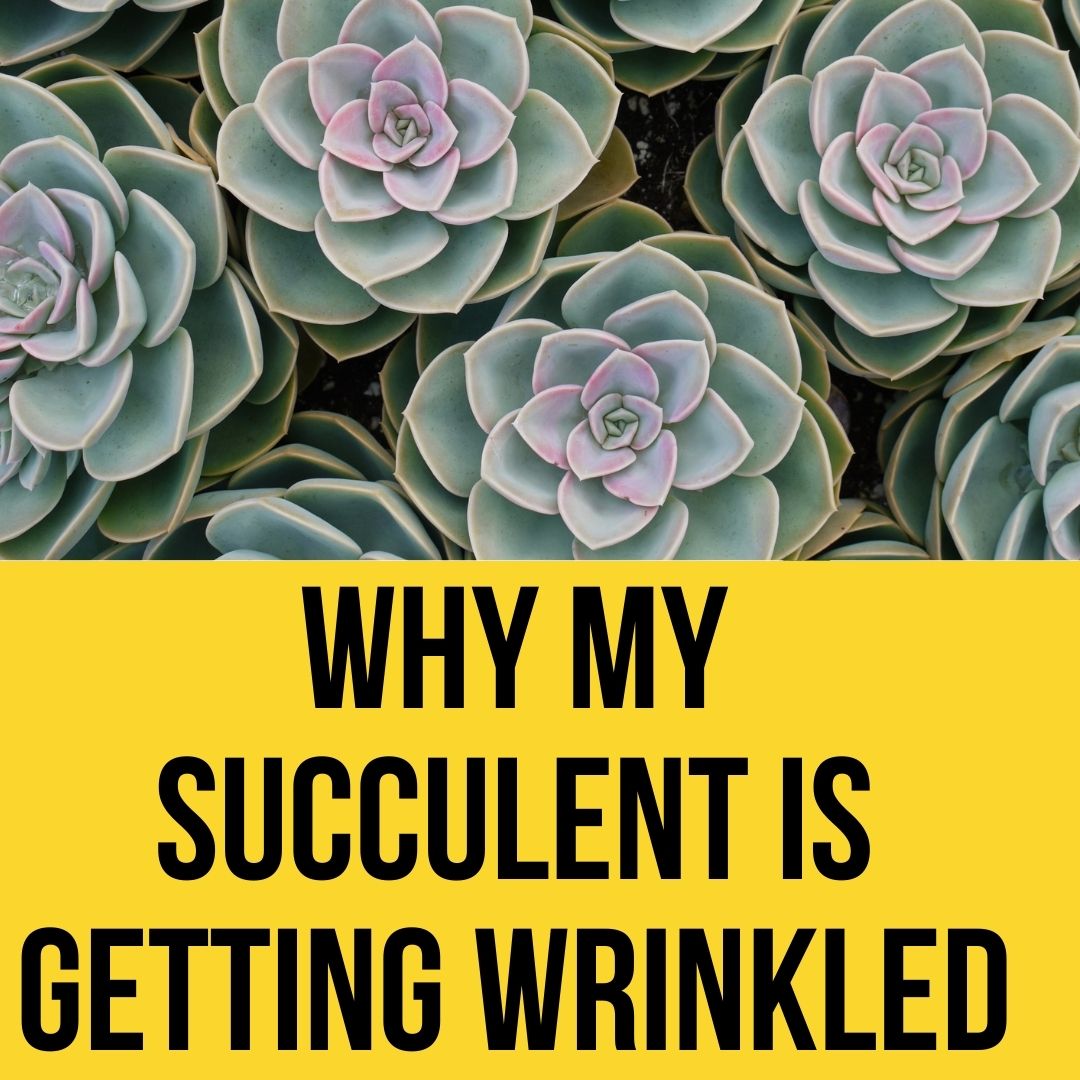Wrinkly succulents, every succulent owner has possibly experienced it. There are a number of reasons behind sickly-looking succulents. It can be difficult to diagnose, but over-watering, under-watering, or excessive exposure to sunlight are most common.
Other factors may include humidity, location of the plants, lack of sunlight, etc.
The appearance of the leaves and testing the soil are some ways to uncover the mystery.
Let’s see why the succulents getting wrinkled, the causes, and the solutions for them.
Overwatered succulents getting wrinkled
Even amongst the common culprits, over-watering is most notorious. New plant parents, especially, make this mistake. Read-up on articles can often be overwhelming or you might come across contradictory information.
Succulents have specific needs, and some enjoy more moisture. You still should avoid watering your succulents often as you are more likely to overdo it. Research on your specific type of succulent is imminent for this reason.
Excessive water causes significant root damage and rotting. In some cases, the rotten roots cannot supply water to the leaves, causing them to be deficient.
Over-watering topped with improper drainage and/or incompatible soil is high on the list of beginner mistakes that cause poor succulent health.
This process can be tricky. You will find your ideal balance through trial and error. Here are some things to look out for:
Soft, mushy, or translucent leaves. Healthy succulents are plump, smooth, and have some texture.
Over-watered succulent leaves appear wrinkly, but swollen, similar to your skin after spending a long time in the water.
It might, however, be difficult to differentiate between too much water and not enough water due to similar wrinkly appearances.
The rule of thumb is to check whether the leaves are flat or swollen. Flat and dry means often under-watered, while mushy and welled-up means the opposite.
Over time, the leaves may swell up extremely and burst.
The leaves appear droopy. In later stages, you may see signs of rotting.
Leaves overly saturated with water will easily fall off. It is soft to the touch.
Among late-stage signs, you may notice discoloration of the leaves (anywhere from yellow to black and rotten).
The discoloration will start from the center of the plant and eventually move to the top. There may also be fungal disease from the excess moisture.
The succulents should only be watered once the soil has completely dried up.
You can buy a moist meter to test the moisture level of your soil. It is easy to find and easier to use.
Your succulent dislikes too much moisture, so watering it even less during winter or humid locations will help preserve your succulent health.

How Long Can Succulents Go Without Water?
Underwatered succulents getting wrinkled
You might be overestimating or misinterpreting the phrase “Succulents love dry air and soil.”
Succulents can survive without water, for weeks on end even! However, it is not ideal for them to thrive. Your succulents still need some hydration to be happy and healthy.
The amount of water your succulents need may differ based on where you put it. Succulents that are at constant or prolonged exposure to sunlight might need more water.
If you are a beginner, consider planting succulents that are more likely to survive trial and error. It will help significantly in determining the ideal baseline for your succulent’s needs.
Alongside wilting, etiolation is another enemy. It rears its ugly head, literally, when sunlight is inadequate. These issues go hand in hand in causing poor succulent health.
Signs to look out for in an under-watered succulent include:
Wrinkly and shriveled up leaves. They fall flat and dry, unlike their over-watered, but wrinkly counterpart.
Under-watered succulents also experience discoloration. The leaves will become dried, crusted, and brown.
If left under-watered for long periods, the leaves will become depleted of water entirely. This exhaust results in droopy and wilted leaves.
The difference between over-watered and under-watered succulent dropping its leaves includes where it begins, the appearance and feel of the dropped leaves, their integrity, etc.
It is dropping its bottom leaves, which dry out and die first. They do this to conserve water as well as their energy.
Water deficit succulents have flat, deflated, and dry leaves. Healthy succulent is supposed to be firm and plump, but not bursting.
In some cases, you might see cracks appearing in the stems from the lack of water.
Miscellaneous Causes
Succulent health may take a hit from rookie mistakes or simply misinformed facts. Excessive sunlight is unhealthy for the succulents as it will dry them out excessively.
Compact soil will cause root rot in the succulents.
Too little sunlight will cause the stem to etiolate (emerge too high from the plant in search of sunlight). This taints the succulent’s otherwise pleasant appearance.
Insufficient sunlight also results in a longer drying time for the soil. This will lead to root rotting.
How to Save an Overwatered Succulent
Depending on the extent of the damage, you will have a few options to save your succulent.
Your succulent loves a good drink sometimes, but you need to be aware of how often you give it that hydration. If you have over-watered your plant, you should wait until the soil has dried up fully before watering again.
Place your succulents on a windowsill facing the south or the east, or a spot in your home with abundant sunlight.
Consider investing in a grow light for your leafy companion. It is sure to appreciate a spot of warmth to manage the extra water. Grow lights are especially convenient if you live in the tropics or are too busy to manage the succulent’s sunlight intake.
Your choice of soil and its assembly affects the succulent’s absorption. Make sure you are using a proper potting mix that will dry easier. Porous, sand-mixed soil is often recommended.
Compact soil suffocates and drowns the roots and causes rotting. You may use a small stick to loosen the soil. This promotes aerating of the soil, and in turn faster drying.
The ventilation of your soil is crucial to avoid over-watering. Porous potting, drainage holes or gravel at the base of the pot, breathable terracotta, light clay or ceramic pots, etc help air out of your succulent.
You may need to repot your succulent altogether if you’ve missed the points above. Try to replicate an ideal succulent environment to avoid transplant shock.
If your succulent seems too moldy or rotten, try to preserve cuttings of whatever of it is least affected for propagation
Planting cuttings won’t save your original plant, since it is essentially a new plant. You would simply be saving pieces of it.
How to save an overwatered succulent
This can be a simpler process compared to its opposite extreme. It is a fairly straightforward process with a quick remedy.
Do not overcompensate for the lack of water. This will lead to you over-watering, thus causing more harm than good.
Check your soil for moisture before watering.
If your watering routine seems inadequate, adjust your routine. You may need to increase the number of days you water the succulent in a week, or how much water you put in.
Tip for Testing Moisture
An easy way to test your soil is to stick a wooden stick or small dowel rod to the bottom of the soil. If your probe comes out dry, you need to water it. If your probe has damp soil stuck to it, you need to wait longer.
You may need to relocate your pot if the soil stays damp for an extended period.
Beginner’s Mistake
The most common mistakes to poor succulent health as beginners deal significant damage to the succulents. They include:
Improper watering routine causing too much or too little hydration.
The use of tap water is a succulent killer. Alongside a proper routine, be sure to use rainwater or distilled water to avoid having minerals mixed into your soil.
Some may think to spray the leaves like other plans. This will cause excess water build-up and lead to wrinkly, unhealthy leaves.
Opt for wetting only the soil instead.
Proper soil mix is significant and irreplaceable. Your roots will die or rot with incompatible soil.
Your container and drainage are essential to your overall plant health and care routine.
Make separate routines according to the weather and type of succulents. Most types are dormant in winter and will barely need any water during this time.
Final Thoughts
Diagnosing wrinkling, sickly-looking succulents can be difficult and confusing. Proper research, experimentation, and building your care knowledge accordingly can help save your succulents and allow them to thrive in any environment.
